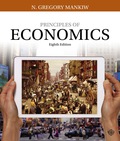
EBK PRINCIPLES OF ECONOMICS
8th Edition
ISBN: 8220103600453
Author: Mankiw
Publisher: CENGAGE L
expand_more
expand_more
format_list_bulleted
Concept explainers
Question
Chapter 31, Problem 2CQQ
To determine
Exchange rate between Paris and New York.
Expert Solution & Answer
Want to see the full answer?
Check out a sample textbook solution
Students have asked these similar questions
In a small open economy, if domestic investment equals $70 billion, domestic private saving equals $40 billion, and government saving equals $30 billion, then the trade balance is:
a. -$30 billion
b. $0 billion
c. $30 billion
d. $40 billion
Suppose that national saving is $1456 billion, investment is $1945 billion, and private saving is $1590 billion. How
much is the current account balance?
A. $221 billion.
B. - $221 billion.
C. $489 billion.
D. - $489 billion.
Discuss the role of budget surpluses and trade surpluses in national saving and investment
Knowledge Booster
Learn more about
Need a deep-dive on the concept behind this application? Look no further. Learn more about this topic, economics and related others by exploring similar questions and additional content below.Similar questions
- Holding other things constant, an increase in anation’s interest rate reducesa. national saving and domestic investment.b. national saving and the net capital outflow.c. domestic investment and the net capital outflow.d. national saving onlyarrow_forwardWhich of the following would be U.S. foreign direct investment? A. A U.S. canning factory opens a plant in Ecuador. B. A Bolivian bank buys U.S. corporate bonds. C. A Polish company opens a shipbuilding plant in the United States. D. A U.S. bank buys Bolivian corporate bonds.arrow_forwardA country’s investment is 8, its government spends 10 and raises 9 in taxes, and its current account is -2. Find the country’s private saving. Find the country’s public saving. How much net investment does the country receive from the rest of the world?arrow_forward
- International financial capital flows into the United States come from: а. income that is not spent in the US. b. savings from the rest of the world. С. the savings of US households. d. the savings of the US government.arrow_forwardSuppose that GDP is equal to 1,000, national saving is equal to 200, the current account deficit is equal to 100, and the government budget deficit is equal to 50. Private savings must equal ( )arrow_forwardWhich of the following are direct foreign investments, and which are not? Event a. A French company merges with an American company; stockholders in the U.S. company exchange their stock for shares in the French firm. b. The same Saudi businessman buys a New York apartment building. c. A Saudi businessman buys $10 million of IBM stock. Is this a direct foreign investment? d. An Italian firm builds a plant in Russia and manages the plant as a contractor to the Russian government. Yes Yes No Noarrow_forward
- Consider the following data for MILESTONES, a hypothetical economy and nation-state. GDP = 8500 billion Government Purchases 500 billion Government Tax Revenue = 1000 billion Welfare Payments = 200 billion Social Security Payments = 400 billion Medicare Payments 300 billion Interest Payments 200 billion Consumption = 7200 billion Gross Investment 800 billion Net Foreign Factor Income = -500 billion PART A 1. What is the level of national saving(NS) in MILESTONES 2. What is the current account (CA) balance in MILESTONES? 3. Describe the current relationship between saving (NS) and gross investment (GI)?arrow_forwardPrivate domestic saving provides the pool of funds available for Private domestic saving provides the pool of funds available for ... only financing government budget deficits putting under one's mattress Domestic investment and financing government budget deficits Consuming goods and servicesarrow_forwardprovides some hypothetical data on macroeconomicaccountsforthreecountriesrepresented by A, B, and C and measured in billions of currency units. In Table, private household saving is SH, tax revenue is T, government spending is G, and investment spending is I. a. Calculate the trade balance and the net inflow of foreign saving for each country. b. State whether each one has a trade surplus or deficit (or balanced trade). c. State whether each is a net lender or borrower internationally and explain.arrow_forward
- The Current Account DOES NOT include: a. Portfolio Investment b. Net income investments in other countries c. Payments in connection with foreign trade. d. Interest on loans to other countries.arrow_forwardWhen an economy's saving is greater than its domestic investment, it implies that: a Net Capital Outflow (NCO) is positive. b Net Capital Outflow (NCO) is negative. c Net Exports (NX) are negative. d There is a trade deficit.arrow_forward. Assume that the gross domestic product is $6,000, personal disposal income is $5,100, the government deficit is $200, consumption is $3,800, and the trade deficit is $100. What is the size of: a. Private Saving b. Investment c. Government Spending d. National Savings e. Taxes f. Public savingsarrow_forward
arrow_back_ios
SEE MORE QUESTIONS
arrow_forward_ios
Recommended textbooks for you
 Brief Principles of Macroeconomics (MindTap Cours...EconomicsISBN:9781337091985Author:N. Gregory MankiwPublisher:Cengage Learning
Brief Principles of Macroeconomics (MindTap Cours...EconomicsISBN:9781337091985Author:N. Gregory MankiwPublisher:Cengage Learning Principles of Macroeconomics (MindTap Course List)EconomicsISBN:9781285165912Author:N. Gregory MankiwPublisher:Cengage Learning
Principles of Macroeconomics (MindTap Course List)EconomicsISBN:9781285165912Author:N. Gregory MankiwPublisher:Cengage Learning Principles of Macroeconomics (MindTap Course List)EconomicsISBN:9781305971509Author:N. Gregory MankiwPublisher:Cengage Learning
Principles of Macroeconomics (MindTap Course List)EconomicsISBN:9781305971509Author:N. Gregory MankiwPublisher:Cengage Learning Economics Today and Tomorrow, Student EditionEconomicsISBN:9780078747663Author:McGraw-HillPublisher:Glencoe/McGraw-Hill School Pub Co
Economics Today and Tomorrow, Student EditionEconomicsISBN:9780078747663Author:McGraw-HillPublisher:Glencoe/McGraw-Hill School Pub Co

Brief Principles of Macroeconomics (MindTap Cours...
Economics
ISBN:9781337091985
Author:N. Gregory Mankiw
Publisher:Cengage Learning

Principles of Macroeconomics (MindTap Course List)
Economics
ISBN:9781285165912
Author:N. Gregory Mankiw
Publisher:Cengage Learning

Principles of Macroeconomics (MindTap Course List)
Economics
ISBN:9781305971509
Author:N. Gregory Mankiw
Publisher:Cengage Learning

Economics Today and Tomorrow, Student Edition
Economics
ISBN:9780078747663
Author:McGraw-Hill
Publisher:Glencoe/McGraw-Hill School Pub Co